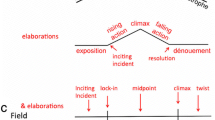Abstract
Nonhuman narrative refers to the representation of events with participants of nonhuman entities. It entails four broad categories: narrative about natural things, such as animals, plants, hills, rocks, water, and salt; narrative about supernatural things, such as gods, goblins, demons, and monsters; narrative about artificial objects, such as cloth, coins, chairs, ink, and toys, and narrative about artificial humans, such as robots, clones, and machines. The nonhuman entities take on the roles of narrator, character, and focalizer in a narrative text, and thus, perform three functions, namely, the telling, acting, and observing functions. An exploration of nonhuman narrative not only enriches the existing narrative theory, but also makes it more comprehensive and goes beyond anthropocentrism. Against the backdrop of the nonhuman turn, this paper proposes a theory of nonhuman narrative and reconsidering human—nonhuman relations so as to engage a larger organic sphere.
Similar content being viewed by others
Notes
I am deeply indebted to the anonymous reviewer for raising this insightful point.
References
Alber, J., et al. (2011). The ethical implications of unnatural scenarios. In J. Alber (Ed.), Why study literature? (pp. 211–233). Aarhus University Press.
Alber, J. (2016). Unnatural narrative: Impossible worlds in fiction and drama. University of Nebraska Press.
Barnes, J. (1990). A history of the world in 10½ chapters. Vintage.
Barthes, R. (1977). An introduction to the structural analysis of narrative. In R. Barthes. Image music text (S. Heath., Trans.) (pp.79-124). Fontana Press.
Bernaerts, L., et al. (2014). The storied lives of non-human narrators. Narrative, 22(1), 68–93.
Blackwell, M. (Ed.) (2007). The secret life of things: Animals, objects, and it-narratives in eighteenth-century England. Bucknell University Press.
Coetzee, J. M., et al. (1999). The lives of animals. Princeton University Press.
Grusin, R. (2015). Introduction. In R. Grusin (Ed.). The nonhuman turn (pp. vii–xxix). University of Minnesota Press.
Fludernik, M. (1996). Towards a natural narratology. Routledge.
Fu, X. Y. (2021). Chinese narratologies. Springer.
Hajdu, P. (2007). The modern Prometheus and the interpretive communities. Neohelicon, 34(1), 59–66.
Hajdu, P. (2020). Terry Pratchett’s thought experiments about the body. Neohelicon, 47(1), 75–87.
Haraway, D. (2015). Anthropocene, capitalocene, plantationocene, chthulucene: Making kin. Environmental Humanities, 6, 159–165.
Herman, D. (2018). Narratology beyond the human: Storytelling and animal life. Oxford University Press.
Hayles, K. (1999). How we became posthuman: Virtual bodies in cybernetics, literature, and informatics. The University of Chicago Press.
Herman, L., & Vervaeck, B. (2019). Handbook of narrative analysis. 2nd edition. University of Nebraska Press.
Homer. (1991). The Iliad (R. Fagles, Trans.). Penguin.
Ishiguro, K. (2021). Kalara and the sun. Faber & Faber Limited.
Kafka, F. (1988). The complete stories. Schocken.
Karkulehto, S., Koistinen, A. K., Lummaa, K., & Varis, E. (2020). Reconfiguring human, nonhuman and posthuman striving for more ethical cohabitation. In S. Karkulehto, A. K. Koistinen, & E. Varis (Eds.), Reconfiguring human, nonhuman and posthuman in literature and culture (pp. 1–19). Routledge.
Latour, B. (2005). Reassembling the social: An introduction to actor-network-theory. Oxford University Press.
Lévi-Strauss, C. (1963). Structural anthropology (C. Jacobson & B. G. Schoepf, Trans.). Basic Books.
Mo, Y. (2008). Life and death are wearing me out (H. Goldblatt, Trans.). Arcade Publishing.
McEwan, I. (2019a). Machines like me. Jonathan Cape.
McEwan, I. (2019b). The cockroach. Anchor Books.
Phelan, J. (1996). Narrative as rhetoric: Techniques, audiences, ethics, ideology. Ohio State University Press.
Phelan, J. (2017). Somebody telling somebody else: Toward a rhetorical poetics of narrative. Ohio State University Press.
Richardson, B. (2015). Unnatural narrative: theory, history, and practice. Ohio State University Press.
Roffe, J., & Stark, H. (2015). Introduction: Deleuze and the non/human. In J. Roffe & H. Stark (Eds.), Deleuze and the non/human (pp. 1–16). Palgrave.
Xu, Z. L. (Ed.) (2000). Creation of the gods (Z. Z. Gu, Trans.). Foreign Languages Press.
Acknowledgements
I am very grateful to Péter Hajdu and the anonymous reviewer for their insightful comments on early versions of this article and helpful suggestions for improvement. This work was supported by the National Social Science Fund of China (Grant Number: 17ZDA281).
Author information
Authors and Affiliations
Corresponding author
Additional information
Publisher's Note
Springer Nature remains neutral with regard to jurisdictional claims in published maps and institutional affiliations.
Rights and permissions
About this article
Cite this article
Shang, B. Towards a theory of nonhuman narrative. Neohelicon 49, 59–73 (2022). https://doi.org/10.1007/s11059-022-00628-y
Accepted:
Published:
Issue Date:
DOI: https://doi.org/10.1007/s11059-022-00628-y



